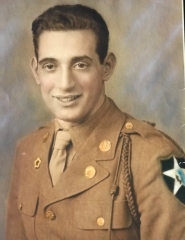Anthony E. Jannace

Anthony E. Jannace
ANTHONY
E.
JANNACE
SOLDIER DETAILS
Army Commendation Medal
Good Conduct Medal
Purple Heart, April 1945
European-African-Middle Eastern Campaign Medal
Presidential Unit Citation Badge
Second Engineer Combat Battalion, 2ID
Battle of the Bulge
December 1944
World War II Victory Medal
National Defense Service Medal
Honorable Service Lapel Button WWII
Sharpshooter Badge with Rifle Bar
BIOGRAPHY
My father, Anthony E. Jannace, enlisted in the U.S. Army after Pearl Harbor was bombed and served in the Second Engineer Combat Battalion of the Second Infantry Division, in the European Theater of Operations during WWII. He participated in five campaigns: The Battle of Normandy, Northern France (Brest), Ardennes-Alsace, the Rhineland, and Central Europe. The battalion he served in received a Presidential Unit Citation (one of 16 the division received) for its heroism during the Battle of the Bulge. During one week in the battle approximately 25% of the battalion suffered casualties while being caught behind the German pincer movements in the Ardennes. He was wounded twice: frost bite and mortar shrapnel and he received The Purple Heart in April 1945 (one of approximately 5,193 awarded to his comrades). He participated as well in the Liberation of Pilsen in May 1945. The Second Infantry Division participated in five campaigns in the ETO, including the Elsenborn Ridge Defense from December 20, 1944 until January 29, 1945 during the Battle of the Bulge-as it has been said-The Germans were defeated at Elsenborn and the Battle was won in Bastogne. It served approximately 337 days in combat, with 320 in contact with the enemy, including 209 straight days in contact with the enemy. It traveled approximately 1,750 miles in combat from Omaha Beach to Pilsen, capturing approximately 70,300 prisoners of war. The division sustained over 15,000 casualties during this period, including nearly 3,000 killed in action. The Second Infantry Division is also a recognized Liberating Unit, having been involved in the liberation of Leipzig Schönefeld (Buchenwald subcamp) and Spergau (labor education camp) in April 1945. Like so many veterans, he spoke little about his experiences during the war. After active duty he served in the U.S. Army Reserves where he retired as an SFC. He was also a member of the DAV. He died in October 1983 after having served nearly 30 years in defense of our country and our freedom. Although wounded twice, he considered his fallen comrades that never returned home the real heroes of the war.
 Eisenhower Foundation
Eisenhower Foundation
